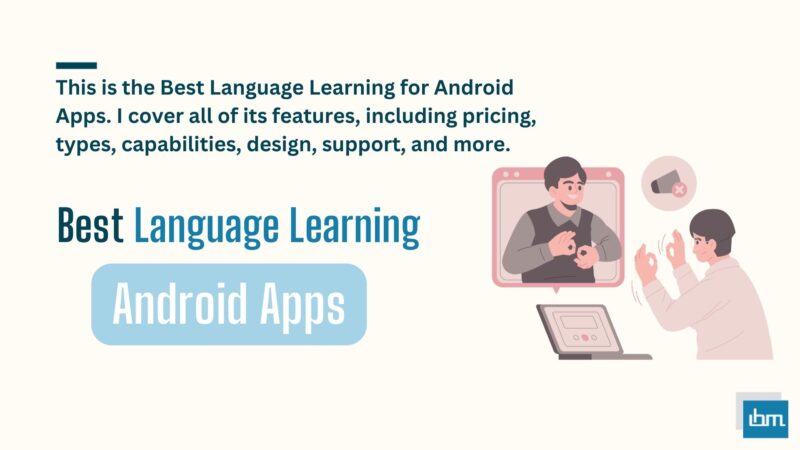Reviewed by: Jayprakash Prajapati | Last updated on October, 1, 2025
Best Language Learning Apps for Android. If you’re looking to learn a new language, Duolingo is a great choice. Its bite-sized lessons, interactive tools, advanced speech recognition, and other features make it accessible and effective.
However, if Duolingo doesn’t meet your preferences, there are nine other excellent language learning apps available. These apps offer various features like dictionaries, pronunciation guides, educational games, flashcards, and the ability to chat with native speakers.
All the apps on our list provide either a free version or a free trial, allowing users to test their features. The best language learning app for you will depend on your learning preferences and budget. We recommend trying out multiple apps and reviewing their pricing information to find the one that suits your needs.
To effectively learn a new language, it’s crucial to practice speaking, reading, and writing daily to retain the information from each lesson. Set up lesson reminders and notifications to ensure you never miss a lesson or forget what you’ve learned.
Language Learning Apps Compared: Features & Benefits for 2025
| App Name | Key Features | Price/Trial | Ratings |
|---|---|---|---|
| Duolingo | Gamified learning, diverse languages, community support | Free; Premium available | 4.7 ★ (Green) |
| Babbel | Real-life conversation focus, grammar emphasis, interactive lessons | Paid subscription; Free trial available | 4.6 ★ (Green) |
| Busuu | Community feedback, personalized learning plans, offline mode | Paid subscription; Free trial available | 4.5 ★ (Green) |
| Pimsleur | Audio-based learning, focus on conversation skills | Paid subscription; Free trial available | 4.3 ★ (Green) |
| Memrise | Video clips of native speakers, spaced repetition, gamified elements | Free; Premium available | 4.5 ★ (Green) |
| Beelinguapp | Bilingual reading, audio support, diverse topics | Free; Premium available | 4.4 ★ (Green) |
| Drops | Visual learning, quick sessions, vocabulary-focused | Free; Premium available | 4.6 ★ (Green) |
| HelloTalk | Language exchange with native speakers, text/audio messaging | Free; Premium available | 4.5 ★ (Green) |
| Rosetta Stone | Immersive method, speech recognition technology | Paid subscription; Free trial available | 4.5 ★ (Green) |
| Mondly | Daily lessons, AR/VR features, chatbot practice | Paid subscription; Free trial available | 4.6 ★ (Green) |
This table summarizes the key features, pricing options including free trials, and user ratings for each language learning app mentioned.
What is Best Language Learning Apps for Android.
Here are my top picks for the Best Language Learning Apps for Android Phones to use for your personal and professional needs. Its bite-sized lessons, interactive tools, advanced speech recognition, and other features make it accessible and effective.
1. Duolingo.

Duolingo stands out as one of the most popular language learning apps available, providing the most comprehensive free version compared to other apps on our list. With a selection of over 35 different languages, users can engage in enjoyable, bite-sized lessons that prioritize proper grammar and pronunciation.
These lessons incorporate reading, speaking, and listening exercises, while users can further enhance their learning experience with stories and audio lessons. Tracking progress, competing on the leaderboard, and earning achievements are all possible on Duolingo.
The best part is that Duolingo is completely free, although users have the option to subscribe for an ad-free experience, unlimited lesson attempts, and more.
Key Features:
- Access the free version now.
- Gamified lessons that make learning fun and engaging.
- Wide range of languages, including popular and less common options.
- Short, bite-sized lessons suitable for busy schedules.
- Progress tracking and daily goals to keep you motivated.
- Choose from subscription plans: Plus for $6.99/month.
- Get assistance from our Help Center.
Pros:
- Over 35 languages are available for free.
- Free to use with optional in-app purchases for premium features.
- User-friendly interface with a vibrant and engaging design.
- Community support and discussion forums for additional practice and assistance.
- Lessons encompass speaking, reading, writing, and listening.
- All languages and lessons come at no cost.
Cons:
- Unable to converse with individuals who speak the language fluently.
- May not provide in-depth grammar explanations or cultural context.
- Limited speaking and conversation practice in the free version.
- Incapable of engaging in conversations with those who are native speakers.
- Not able to communicate with people who are fluent in the language.
2. Babbel.

Babbel stands out as the top language learning app, offering a school-like learning experience that is unparalleled among other apps on our list. With each lesson, Babbel guides you through translations of various words and phrases, presenting common variations as well.
Engaging in practice conversations that mirror real-world scenarios sets Babbel apart from its competitors. Moreover, the app customizes each lesson to your native language, ensuring easier comprehension. The lessons are conveniently designed to last 15 minutes, and you can even set up reminders to keep you on track. However, it’s worth noting that Babbel falls short in terms of language options, as it only offers 14 languages compared to other apps on our list.
Key Features:
- Access the free version now.
- Focus on conversational skills and real-life dialogue.
- Comprehensive lessons covering vocabulary, grammar, and cultural insights.
- Speech recognition technology for pronunciation practice.
- Personalized review sessions to reinforce learning.
- Choose from various subscription plans: 1 month for $13.95, 3 months for $9.95, 12 months for $6.95, or lifetime for $249.
- Get support through Help Center, FAQs, or Email.
Pros:
- Learn in just 15 minutes with our accessible lessons.
- High-quality content developed by language experts.
- Effective methodology for building practical language skills.
- User-friendly interface with clear and structured lessons.
- Lessons designed specifically for your native language.
- Easily download lessons for offline learning.
Cons:
- Consists of just 14 languages.
- Requires a subscription for full access to all lessons and features.
- Limited language options compared to other apps.
3. Busuu.
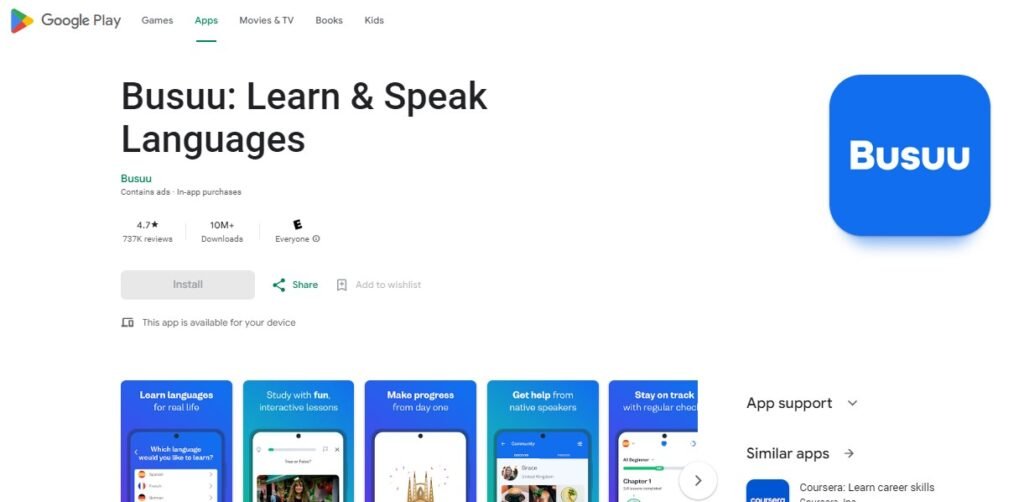
Busuu is a language learning platform that customizes study plans based on users’ goals and proficiency. Upon starting with Busuu, the app assesses your language skills and designs a personalized study plan to assist you in reaching your long-term learning objectives.
Unlike other language learning apps that offer fixed study plans, Busuu allows you to specify your preferred study schedule and duration, enabling the app to create a tailored plan that suits your needs. With Busuu, you can enhance your vocabulary, acquire practical phrases, refine your grammar, and engage in Conversations with native speakers to practice your language skills.
Key Features:
- Access the free version of the product.
- Choose from two subscription plans: Premium for $9.99/month or Premium Plus for $13.99/month.
- Get support through the Help Center.
Pros:
- Tailored learning schedules.
- Language drills and word practice.
- Conversations with fluent speakers.
Cons:
- Provides a selection of just 13 languages.
4. Pimsleur.
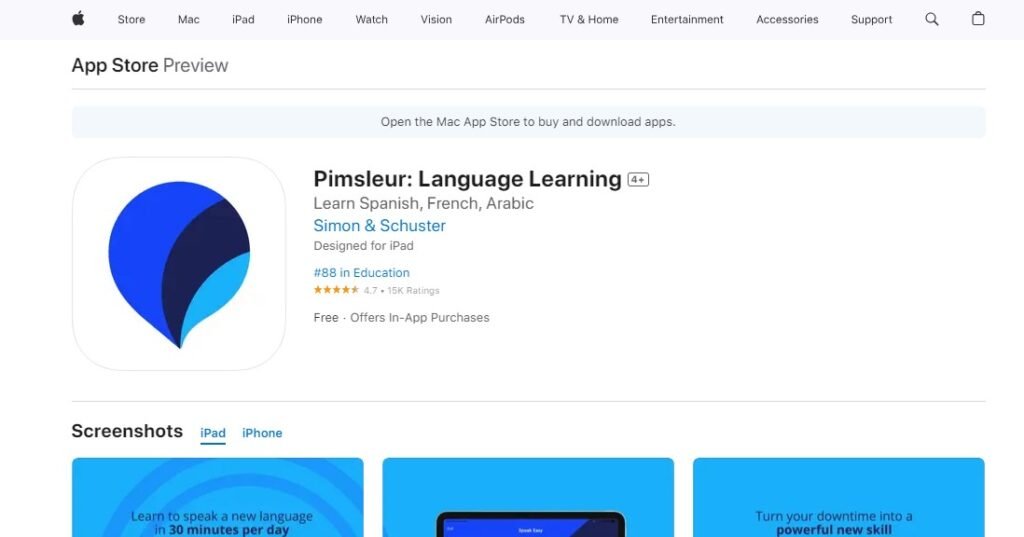
Download: iOS
Pimsleur, similar to Rosetta Stone, initially provided language lessons through cassette and CD formats before transitioning into a popular language learning app. With 30-minute conversational lessons, users can easily practice speaking their chosen language while on the go, at the gym, or in the comfort of their own home using either their Amazon Alexa device or the web-based app.
What sets Pimsleur apart from other options is its extensive range of study tools, such as vocabulary flashcards, Speak Easy challenges for realistic conversations, and skill-building activities like Quick Matches and Speed Rounds. Offering a total of 51 languages, Pimsleur surpasses most language learning apps available on both iOS and Android platforms.
Key Features:
- Get started for free.
- Choose from our subscription plans: All Access for only $20.95/month.
- Reach out to us for support through FAQs, Contact Form, or Phone Call.
Pros:
- Offers a wide range of 51 languages to choose from.
- Provides an extensive selection of practice tools and activities.
- Includes 30-minute conversation lessons for effective learning.
Cons:
- Lacks an integrated dictionary.
- Membership fee is quite high.
- Does not include a built-in dictionary.
5. Memrise.

Memrise is an exceptional language learning app that prioritizes teaching users the art of speaking languages like a native. What sets Memrise apart is its remarkable Learn with Locals feature, where you can immerse yourself in videos showcasing native speakers in real-life scenarios.
This invaluable resource enables users to grasp the authentic pronunciation of various words and phrases. From ordering at a coffee shop to belting out karaoke, these videos cover a wide range of situations.
Additionally, Pronunciation Mode allows you to assess your own speaking skills, while the innovative Explore feature utilizes your camera to identify objects and provide translations in different languages.
Key Features:
- Access the free version now.
- Innovative approach using mnemonic techniques and gamified learning.
- Wide range of languages and courses created by native speakers.
- Interactive video clips for immersive learning experiences.
- Progress tracking and personalized learning plans.
- Choose from subscription plans: Pro for $8.49/month, $59.99/year, or $119.99 for a lifetime.
- Get support through Help Center, FAQs, Community Forum, Contact Form, or Press Kit.
Pros:
- Native speakers are available to teach you through Learn with Locals.
- Engaging and fun learning experience with a focus on retention.
- Community-driven content with courses tailored to specific interests.
- Free version available with optional premium features.
- Your pronunciation is assessed through this platform.
- Utilize your camera to gain knowledge about objects in your vicinity.
Cons:
- Lessons created by users may contain inaccuracies.
- Limited depth in grammar and writing practice.
- Some courses may vary in quality depending on user contributions.
- User-generated lessons have the potential to be inaccurate.
- Inaccuracy can be found in lessons generated by users.
6. Beelinguapp.
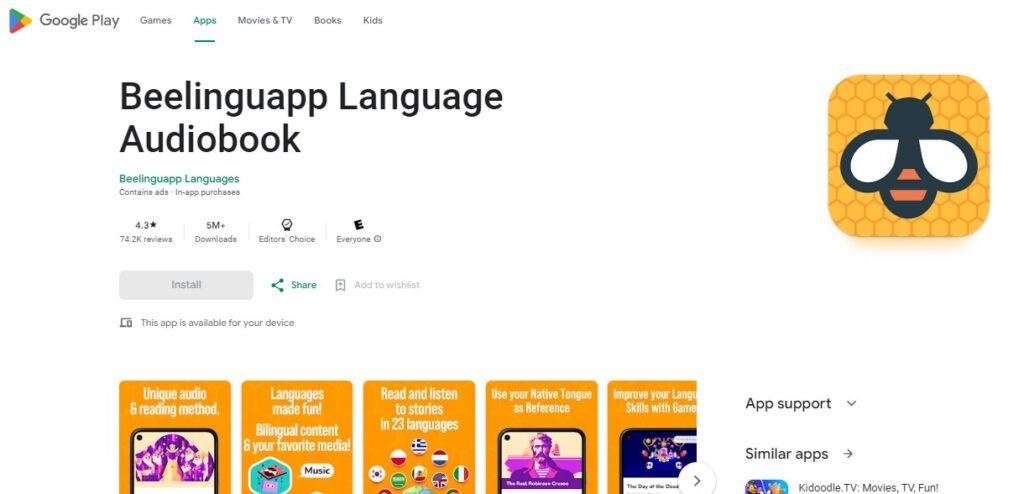
Beelinguapp stands out as the top language learning app for individuals who prefer to learn through reading and text-based lessons. It offers a unique approach to language education by incorporating various forms of media such as e-books, audiobooks, articles, news stories, and more.
Additionally, users can even learn by listening to music. As you read, you have the option to add words to your glossary, tap on them for further information, and practice pronunciation. By reading stories in two languages side-by-side and listening to audio, users can enhance their comprehension skills.
The stories available range from beloved fairy tales like “Snow White” to informative city and culture guides. Upon completing a story, you can take a quiz to assess your reading comprehension abilities.
Key Features:
- Access the free version.
- Choose from subscription plans: Premium for $5.99/month, $26.99/six months, or $19.99/year.
- Reach out for support via email.
Pros:
- Enhance language skills through engaging stories.
- Explore diverse topics with music and news articles.
- Assess understanding with interactive quizzes.
Cons:
- Educational games are not included in the dictionary.
- The dictionary does not contain any educational games.
- There are no educational games in the dictionary.
7. Drops.
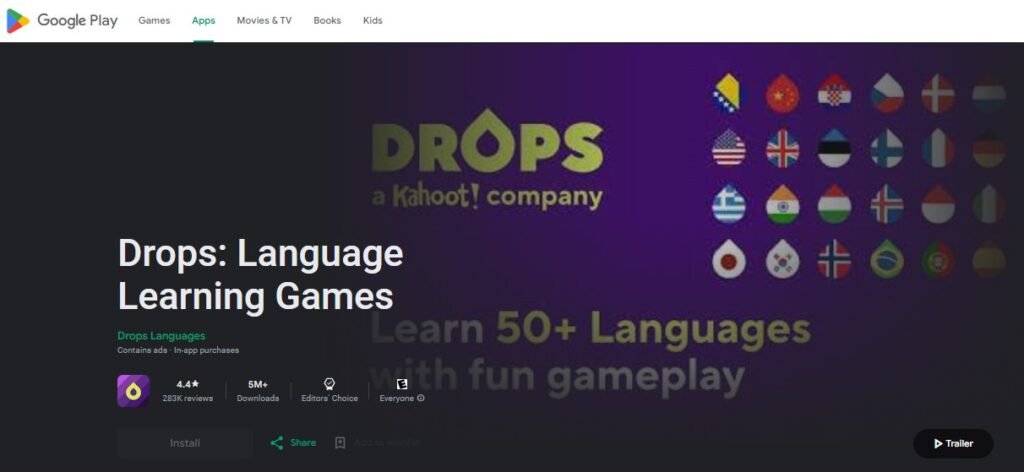
Drops stands out from the rest of the apps on our list by providing quick and easy five-minute lessons. With Drops, users can delve into 45 diverse languages using engaging educational games, vocabulary exercises, and writing lessons.
What sets Drops apart is its visual approach, presenting new words through illustrations instead of translations, making it ideal for visual learners.
Moreover, Drops offers over 2,600 practical words in 100 topics for each language, ensuring users learn vocabulary that is relevant and useful for conversations with native speakers. If you’re looking to learn a new language for travel, Drops is the perfect choice.
Key Features:
- Access the free version of the product.
- Choose from different subscription plans: Premium monthly for $8.49, yearly for $60, or lifetime for $149.99.
- Get support through the Help Center and FAQs.
Pros:
- Emphasizing visual learning techniques.
- Short and concise lessons lasting 5 minutes.
- Centered on visual learning methods.
Cons:
- Unable to engage in conversations with fellow native speakers.
- Limited diversity in lessons.
- No opportunity to interact with other native speakers.
8. Hellotalk.
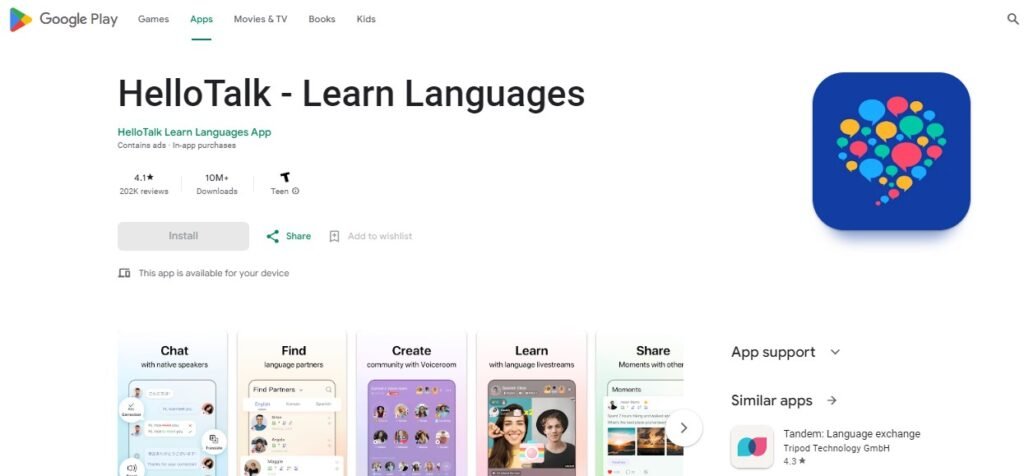
To achieve fluency in a language, practicing conversation with native speakers is crucial. HelloTalk facilitates this by linking you with fellow users for interactive discussions and feedback.
You can inquire about languages, cultures, or travel, and even send voice messages for pronunciation feedback. Additionally, users can engage in video calls, receive one-on-one tutoring, and utilize HelloTalk’s grammar correction feature to enhance their language skills.
Despite this, HelloTalk falls short in providing structured educational materials such as games and flashcards.
Key Features:
- Access the free version today.
- Choose from subscription plans: VIP at $12.99/month, $79.99/year, or $159.99 for a lifetime.
- Get support through email whenever needed.
Pros:
- Engage in conversations with people who speak the language fluently.
- Utilize text, voice, and video features for communication.
- Receive personalized lessons from instructors on an individual basis.
Cons:
- Absence of flashcards.
- Educational games are missing.
- Flashcards are not available.
9. Rosetta Stone.

Rosetta Stone stands out as a popular language learning tool that focuses on audio-based lessons. It sets itself apart from other apps by fully immersing users in the target language, encouraging them to think in that language.
With 24 languages available, lessons are designed to be brief at just 10 minutes each, ensuring accessibility. Users can utilize the Phrasebook to learn new expressions, employ Search & Speak to expand vocabulary, work on pronunciation, and enjoy reading stories in their chosen language.
Key Features:
- Access the free version now.
- Immersive learning methodology that emphasizes intuitive learning.
- Interactive lessons with images, audio, and text.
- Speech recognition technology for pronunciation practice.
- Offline mode for learning without an internet connection.
- Choose from subscription plans: 3 months for $35.97, 12 months for $143.88, or Lifetime for $299.
- Get support through FAQs, Online Chat, Email, or Phone.
Pros:
- Engaging learning experiences.
- Compact lessons.
- Proven track record with a well-established learning system.
- High-quality content with a focus on building a strong language foundation.
- Flexible learning options with a mobile app and desktop version.
- Tailored study schedules based on skill level.
Cons:
- No need for placement exams.
- Relatively expensive compared to other language learning apps.
- May require additional resources for advanced grammar and writing skills.
- Placement tests not required.
- Placement assessments are unnecessary.
10. Mondly.
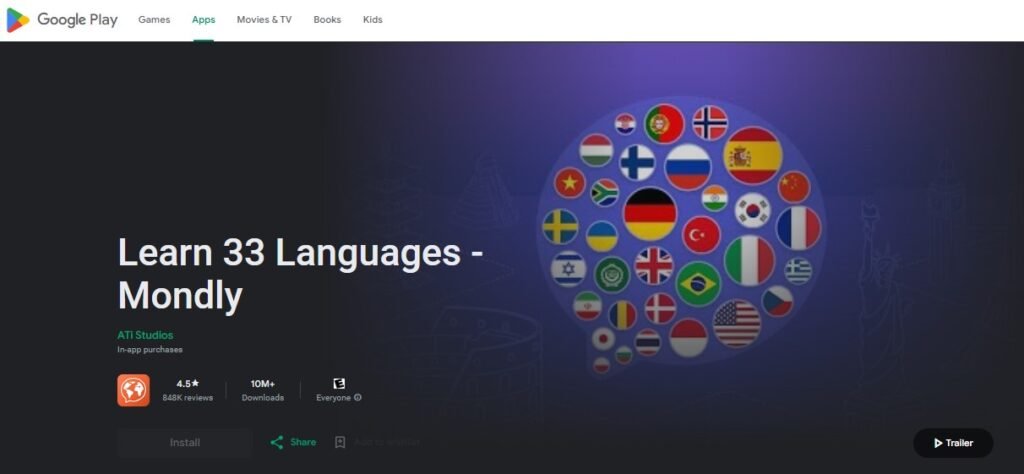
Mondly, a popular language learning app, takes a unique approach by focusing on teaching practical phrases instead of starting with vocabulary. This method allows users to easily engage in conversations.
Additionally, Mondly offers the opportunity to improve pronunciation skills through interactions with native speakers and an AI chatbot. The app also includes an augmented reality feature that enhances learning about real-world objects.
While the free version provides a new lesson each day, the premium version grants access to the entire collection of over 2,500 interactive lessons. Furthermore, Mondly allows users to connect with friends, fostering a collaborative and motivating learning environment.
Key Features:
- Access the free version of the product.
- Choose from two subscription plans: Premium at $9.99 per month or $47.99 per year.
- Get support through FAQs or Email.
Pros:
- Gain practical language skills through interactive exercises.
- Enhance conversational abilities by engaging with chatbots.
- Collaborate with peers to improve language proficiency.
Cons:
- Grammar lessons are not provided in sufficient detail.
- The lack of detailed grammar lessons is evident.
- Detailed grammar lessons are missing from the curriculum.
How to Choose the Best Language Learning App for Your Needs
Choosing the right language learning app is essential for achieving fluency and maintaining motivation. Start by identifying your learning goals. Are you looking to converse casually, or do you need to master formal grammar and writing?
Apps like Duolingo, Babbel, and Rosetta Stone vary in their approach, so consider what suits your needs. Next, check the app’s method of instruction. Some focus on vocabulary and pronunciation, while others integrate grammar, culture, and conversational practice. It’s crucial to find one that aligns with your learning style, whether you prefer interactive lessons, games, or video content.
Also, look for an app with a user-friendly interface and flexibility. You’ll want one that fits into your schedule and allows for practice on-the-go. Read reviews and watch tutorials to assess the quality of lessons and support options available.
Most apps offer a free trial, so take advantage of that to evaluate if it’s effective for you. Finally, ensure the app offers language options that match your target language and level. By aligning the app with your personal learning goals and preferences, you’ll be on the right track to language mastery.
Benefits of Using Language Learning App
Language learning apps offer a convenient and flexible way to master a new language, making them an excellent tool for both beginners and advanced learners. One of the main benefits is accessibility; you can practice anytime, anywhere, making it easier to incorporate language learning into your daily routine.
These apps are often designed to be engaging, with gamified features that keep learners motivated and focused. Many apps also offer tailored learning paths based on your progress and goals, ensuring a personalized experience. Furthermore, language apps often emphasize vocabulary and pronunciation, helping you build a solid foundation and enhancing your speaking skills.
Some apps even offer cultural insights and real-world phrases, enriching the learning process. Another advantage is affordability; compared to traditional classes, many language learning apps are budget-friendly or offer free content, making language learning more accessible to a wide audience.
Lastly, language apps promote consistency, with features like reminders and progress tracking that encourage regular practice. Whether you’re learning on your commute or during a lunch break, language learning apps make it easier to achieve fluency at your own pace.
Tips To Get The Most Out Of Your Language Learning App
To maximize your language learning app experience, consistency is key. Set aside dedicated time each day to practice, even if it’s just 10-15 minutes. Daily practice helps reinforce vocabulary, grammar, and pronunciation.
Another tip is to set achievable goals. Break down your learning into manageable chunks, such as mastering a new set of vocabulary or completing a specific lesson module. This helps keep you motivated and prevents burnout. Engage with the app’s features to stay interactive. Many apps offer speaking exercises, quizzes, and audio recordings to help you practice speaking and listening.
Take full advantage of these to improve your pronunciation and comprehension. Don’t rely solely on the app’s content; complement your learning with real-life practice. Join language exchange platforms, watch movies or listen to music in your target language to immerse yourself. Track your progress and celebrate small victories, like completing a level or learning a new set of words.
This keeps you motivated and boosts confidence. Lastly, be patient and persistent. Language learning is a marathon, not a sprint. Regular practice, paired with the right mindset and strategies, will ensure you make steady progress towards fluency.
FAQs About Language Learning Apps for Android in 2025
Duolingo and Memrise are widely regarded as the top free language learning apps for Android, offering extensive language options and engaging learning methods. Other notable mentions include Busuu, Beelinguapp, and HelloTalk, each providing unique features tailored to different learning styles.
Yes, many language learning apps like Duolingo and Memrise allow users to learn multiple languages simultaneously. Duolingo supports over 40 languages, making it a versatile choice for polyglots.
Duolingo is known for its gamified approach to learning, which includes bite-sized lessons, interactive exercises, and a reward system. It also offers a wide range of languages and a structured curriculum that helps learners progress effectively.
Language learning apps can be effective for building vocabulary and basic grammar skills. However, they are often best used as supplementary tools alongside other methods such as conversation practice and immersive experiences.
Benefits of using language learning apps include flexibility in learning pace, accessibility on mobile devices, engaging content through games and challenges, and the ability to practice listening, speaking, reading, and writing skills in an interactive manner.
While many language learning apps offer free versions with essential features, they often have premium subscriptions that provide additional content and functionalities. For instance, Duolingo offers a premium version called Super Duolingo for $7.99 per month.
Duolingo is highly recommended for beginners due to its structured lessons that gradually introduce vocabulary and grammar concepts in an engaging format. It is user-friendly and ideal for those starting their language journey.
While it is possible to learn basic skills through an app, achieving fluency typically requires additional resources such as conversation practice with native speakers, cultural immersion, and formal study methods.
The five steps to effective language learning include setting clear goals, practicing regularly through daily lessons, engaging with native speakers for real-life practice, utilizing additional resources like podcasts or videos, and reviewing learned material consistently to reinforce knowledge.
Conclusion
Language learning apps for Android have transformed how individuals acquire new languages, offering diverse methods tailored to various learning styles. These applications leverage technology to create engaging, interactive experiences that facilitate language acquisition through audio, visual, and kinesthetic learning approaches.
One of the standout features of many language learning apps is their personalization. Apps like Duolingo and Babbel adapt to the user’s proficiency level and learning preferences, ensuring that each lesson is relevant and effective. This adaptability helps learners remain motivated and engaged, as they can progress at their own pace while receiving immediate feedback on their performance.
Moreover, the gamification of language learning has proven to be a highly effective strategy. By incorporating elements such as points, levels, and rewards, apps make the process enjoyable and less intimidating. This approach encourages users to practice consistently, which is crucial for language retention and fluency.
The integration of audio-visual resources further enhances the learning experience. Many apps provide pronunciation guides, video tutorials, and interactive exercises that cater to different learning styles. This multimodal approach not only aids comprehension but also helps learners develop essential speaking and listening skills.
Finally, the community aspect of language learning apps cannot be overlooked. Platforms like Busuu allow users to interact with native speakers for practice and feedback, fostering a sense of connection and cultural exchange. This social interaction enriches the learning experience and provides real-world context for language use.
In conclusion, Android language learning apps represent a dynamic blend of personalization, gamification, multimedia resources, and community engagement. These elements collectively contribute to a more effective and enjoyable language learning journey.

